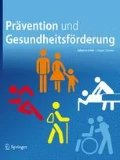Zusammenfassung
Hintergrund
Bei Gesundheitsförderung und Prävention in sozial benachteiligten Wohngebieten muss beachtet werden, dass auch innerhalb dieser Wohngebiete soziale Unterschiede vorhanden sein können. Bisher liegen dazu jedoch kaum empirische Studien vor.
Material und Methoden
Grundlage ist eine im Jahr 2004 durchgeführte Bewohnerbefragung bei 668 Erwachsenen im Münchner APUG-Projekt („Aktionsprogramms für Umwelt und Gesundheit“). Der Sozialstatus wird mit 4 Variablen erfasst: Schulabschluss, Pro-Kopf-Einkommen, Arbeitslosigkeit, Art der Wohnung. Abhängige Variablen sind die Zufriedenheit mit der Wohnsituation und das Gesundheitsverhalten.
Ergebnisse
Innerhalb dieses Gebiets gibt es große soziale Unterschiede. Die Bewohnerinnen und Bewohner mit niedrigem sozialem Status sind besonders unzufrieden mit der Wohnsituation, sie treiben weniger Sport und sie verbringen mehr Zeit vor dem Fernseher.
Schlussfolgerungen
Die „soziale Binnendifferenzierung“ in dieser APUG-Region ist groß. Vor der Implementierung eines Interventionsprogramms muss daher gezielt gefragt werden, welche Gruppe von Bewohnerinnen und Bewohnern welche Maßnahmen benötigt.
Abstract
Background
For health promotion and prevention in deprived regions it should be considered that also within those areas there could be large social differences. This has rarely been assessed in empirical studies.
Methods
The analysis is based on a survey conducted in 2004 in an ”APUG-Region” in Munich. Data from 668 adults could be included. Social status is defined by four variables: educational level, per capita income, unemployment and type of residence. The dependent variables are: health behaviour and satisfaction with living conditions.
Results
There are large social differences within this area. As compared with higher status residents, residents with low social status are more dissatisfied with their living conditions, are less active in sports and watch more TV than residents with higher social status.
Conclusions
There are large social differences within this urban area. It should be asked, therefore, what kind of intervention programme is most appropriate for each social group.
Literatur
Bolte G (2006) Environmental Justice – Umweltgerechtigkeit. Umweltmed Forsch Prax 11(3):161–172
Brown P, Mayer B, Zavestoski S et al (2003) The health politics of asthma: Environmental justice and collective illness experience in the United States. In: Soc Sci Med 57:453–464
Bundesamt für Strahlenschutz, Bundesinstitut für Risikobewertung, Robert Koch-Institut, Umweltbundesamt (Hrsg) (2008) UMID-Themenheft: Umweltgerechtigkeit – Umwelt, Gesundheit und soziale Lage. Ausgabe 2/2008. RKI, Berlin
Elvers HD (2007) Umweltgerechtigkeit als Forschungsparadigma der Soziologie. Soziologie 36(1):21–44
Jackson R (2003) The impact of the built environment on health: An emerging field. Am J Public Health 93:1382–1384
Joshi H, Wiggins R, Barthley M et al (2000) Putting health inequalities on the map: does where you live matter, and why? In: Graham H (ed) Understanding health inequalities. Open University Press, Buckingham Philadelphia, pp 143–157
Lampert T, Kroll L, Dunkelberg A (2007) Soziale Ungleichheit der Lebenserwartung in Deutschland. Politik Zeitgesch 42:11–18
Lampert T, Ziese T (2005) Armut, soziale Ungleichheit und Gesundheit. Expertise des Robert Koch Instituts zum 2. Armuts- und Reichtumsbericht der Bundesregierung. Beiträge zur Gesundheitsberichterstattung des Bundes. Robert Koch-Institut, Berlin
Maschewsky W (2001) Umweltgerechtigkeit, Public Health und soziale Stadt. Akademische Schriften, Frankfurt/M
Mielck A (2005) Soziale Ungleichheit und Gesundheit. Einführung in die aktuelle Diskussion. Huber, Bern
Mielck A, Bolte G (2004) Die soziale Verteilung von Umweltbelastungen: Neue Impulse für Public Health Forschung und Praxis. In: Bolte G, Mielck A (Hrsg) Umweltgerechtigkeit. Die soziale Verteilung von Umweltbelastungen. Juventa, Weinheim, S 175-198
Mielck A, Heinrich J (2002) Soziale Ungleichheit und die Verteilung umweltbezogener Expositionen (Environmental Justice). Gesundheitswesen 64:405–416
Nagel LM (2003) Soziale Ungleichheiten im Sport. Meyer & Meyer, Aachen
Pearce N, Davey Smith G (2003) Is Social Capital the Key to Inequalities in Health? In: Am J Public Health 93:122–129
Richter M, Hurrelmann K (Hrsg) (2006) Gesundheitliche Ungleichheit. Grundlagen, Probleme, Perspektiven. VS für Sozialwissenschaften, Wiesbaden
Schöppe S, Braubach M (2007) Wohnen, Bewegung und Gesundheit. Public Health Forum 15(3):2–6
Interessenkonflikt
Der korrespondierende Autor gibt an, dass kein Interessenkonflikt besteht.
Author information
Authors and Affiliations
Corresponding author
Rights and permissions
About this article
Cite this article
Koller, D., Spies, G., Bayerl, B. et al. Soziale Unterschiede bei Wohnzufriedenheit und gesundheitlichen Risiken. Praev Gesundheitsf 5, 129–135 (2010). https://doi.org/10.1007/s11553-009-0214-9
Published:
Issue Date:
DOI: https://doi.org/10.1007/s11553-009-0214-9

